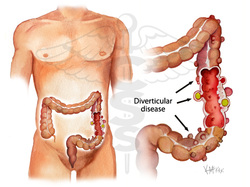|
|
Pathology definition - Diverticular disease

Diverticular disease
There are a few form of diverticular disease which include diverticula, diverticulosis and diverticulitis.
Diverticula are the blind pouches which projected off the gastrointestinal tract which communicate with lumen of the gut. There are two form of diverticula. There are true diverticula and false diverticula. True diverticula or traction diverticula consists of serosa, muscularis and mucosa. False diverticula or pulsion diverticular occur due to herniation of the mucosa through the defect in the layer of the mucosal. There will be an atrophy of the mucosa with thin muscularis propria.
The present of multiple diverticula is known as diverticulosis. diverticulosis mostly occur due to low fiber diet and affecting people age more than 60 years old. There is an increase in the pressure of the bowel with weakness of the wall of the bowel. Patient with diverticulosis may appear asymptomatic. However, patient may suffer with frank blood in the stool and abdominal pain. Patient with diverticulosis is treated with high fiber diet and psyllium high fiber laxatives.
Diverticulitis is caused by inflammation of the diverticula due to irritation of the diverticula by fecal material impaction. Diverticulitis is associated with edematous and inflammatory infiltration. Patient who suffer from diverticulitis may present with bright red blood in the stool, fever, peritonitis, perforation, chronic colicky abdominal pain at the left lower quadrant, abscess formation and stenosis of the bowel.The treatment of diverticulitis include high fiber diets and antibiotics.
References
1.Köhler, L., S. Sauerland, E. Neugebauer, R. Caprilli, A. Fingerhut, N. Y. Haboubi, L. Hultén, et al. “Diagnosis and Treatment of Diverticular Disease.” Surgical Endoscopy 13, no. 4 (April 1, 1999): 430–436. doi:10.1007/s004649901007.
2.Stollman, Neil, and Jeffrey B Raskin. “Diverticular Disease of the Colon.” The Lancet 363, no. 9409 (February 21, 2004): 631–639. doi:10.1016/S0140-6736(04)15597-9.
There are a few form of diverticular disease which include diverticula, diverticulosis and diverticulitis.
Diverticula are the blind pouches which projected off the gastrointestinal tract which communicate with lumen of the gut. There are two form of diverticula. There are true diverticula and false diverticula. True diverticula or traction diverticula consists of serosa, muscularis and mucosa. False diverticula or pulsion diverticular occur due to herniation of the mucosa through the defect in the layer of the mucosal. There will be an atrophy of the mucosa with thin muscularis propria.
The present of multiple diverticula is known as diverticulosis. diverticulosis mostly occur due to low fiber diet and affecting people age more than 60 years old. There is an increase in the pressure of the bowel with weakness of the wall of the bowel. Patient with diverticulosis may appear asymptomatic. However, patient may suffer with frank blood in the stool and abdominal pain. Patient with diverticulosis is treated with high fiber diet and psyllium high fiber laxatives.
Diverticulitis is caused by inflammation of the diverticula due to irritation of the diverticula by fecal material impaction. Diverticulitis is associated with edematous and inflammatory infiltration. Patient who suffer from diverticulitis may present with bright red blood in the stool, fever, peritonitis, perforation, chronic colicky abdominal pain at the left lower quadrant, abscess formation and stenosis of the bowel.The treatment of diverticulitis include high fiber diets and antibiotics.
References
1.Köhler, L., S. Sauerland, E. Neugebauer, R. Caprilli, A. Fingerhut, N. Y. Haboubi, L. Hultén, et al. “Diagnosis and Treatment of Diverticular Disease.” Surgical Endoscopy 13, no. 4 (April 1, 1999): 430–436. doi:10.1007/s004649901007.
2.Stollman, Neil, and Jeffrey B Raskin. “Diverticular Disease of the Colon.” The Lancet 363, no. 9409 (February 21, 2004): 631–639. doi:10.1016/S0140-6736(04)15597-9.
